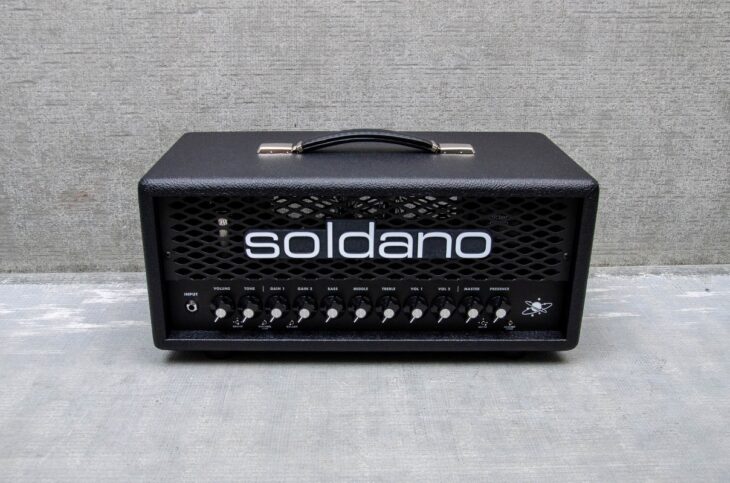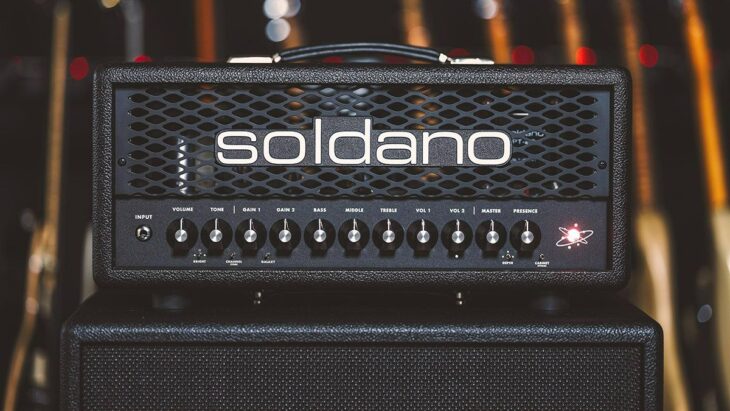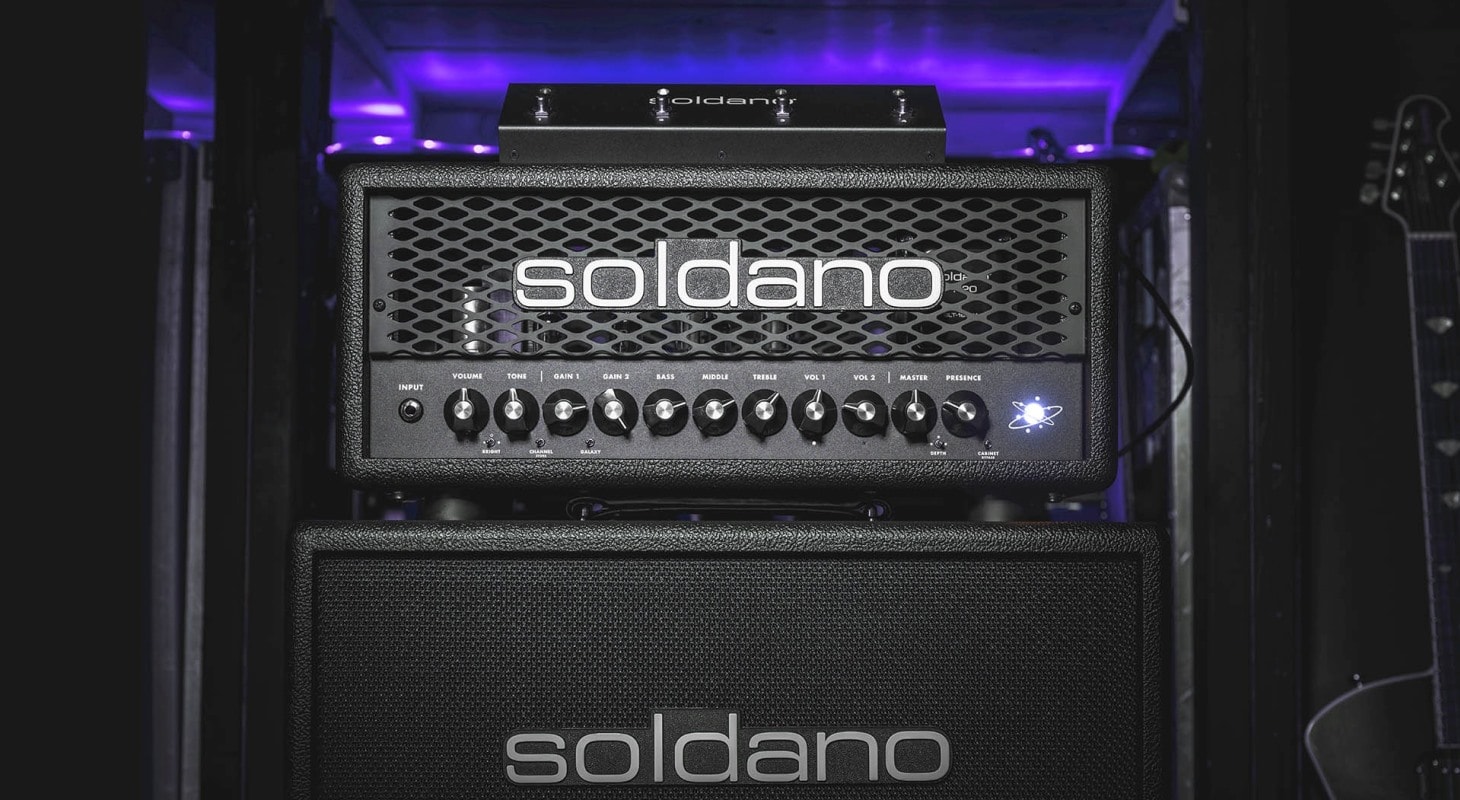Do you know what Eric Clapton, Stevie Ray Vaughan, Gary Moore, BB King, Mark Knopfler, and George Harrison have in common with Eddie Van Halen, George Lynch, Joe Satriani, Steve Vai, Jerry Cantrell, and J Mascis?
Well, besides being guitar legends, they all enjoyed Soldano’s uncanny tone at a given time in their careers.
Mike Soldano is an amp guru who made it big in the ‘80s with a modded Marshall tone. Now, he’s back with a bombastic piece of gear capable of closing the gap between past and present. Furthermore, this amp can resolve the good old “tubes vs. digital” discussion.
Mike took two decades to come up with a completely new amp, the Astro 20. It took me only 20 minutes to fall in love with it.
Table of Contents
3 Channels and 4 Galaxies

Mike Soldano’s new creation features three independent channels with a few front knobs on a rather small and lightweight amp design. Although the layout might seem simple, this head packs some serious power under the hood.
To begin with, the circuit takes the power and grit from a pair of 6V6 power tubes and four 12ax7s serving the preamp’s tone-shaping capabilities. There are also some switches to choose between different bright and depth settings adding high and low end to the sound respectively.
Using it like a regular amp is as easy as it gets. The normal channel has a volume and a tone control while the overdrive channels share a set of EQ controls. Also, these channels have a separate gain and volume knob for each.
Finally, the amp doesn’t sport any reverb but it has an effects loop for it. The equation is completed with a master presence knob and a master volume knob. This last one is very handy when you want to hear the amp roar without annoying your neighbors or being killed by the people in the first row.
Last, in the front panel, you have a galaxy indicator that goes from green to red indicating the movement from clean to mayhem.
Does This Amp Need EQ Controls?
Have you ever plugged your guitar into an amp that sounded amazing with everything at noon? Well, although the EQ controls on this Soldano are very capable of transforming tone, it’s very hard to make this amp sound bad. I mean, you can go for that ‘80s-approved scooped sound with lots of treble and bass, but the amp just sounds amazing right out of the box.
So, if Mike had decided not to include any equalization in the design, the amp would be just as good. Perhaps not as versatile, but amazing anyway.
The Green Galaxy and The Clean Channel
According to Soldano, the clean channel (restricted to the green galaxy only) is voiced to mimic the tones of a clean Fender combo with a big clean headroom. I mean, it’s loaded with 6V6s, the same tubes you get inside a Fender Deluxe Reverb, for example. Although it’s rated at just 20 watts, let me tell you that this channel is loud, clean, and proud.
When lowering the Master Volume and pushing the channel’s volume knob, what you get is a mildly compressed, softly overdriven sound without going into full distortion. This is not what happens when you crank either a Deluxe or Princeton Reverb amplifier. Those go into a fatter-sounding distortion.
I tried this channel through a 1×12 open-back cabinet and the result was very combo-like with sweet harmonic overtones and a nice headroom.
Going from my Telecaster to my humbucker-equipped Ibanez, the amplifier did a great job at letting the character of each guitar shine through. With the Telecaster, it was a shimmering, sparkling, beautiful Fender-like combo amp and with the Ibanez, I got a more modern, Mesa-like clean tone with enough complexity to play modern music.
The Blue Galaxy, Pushing It a Little

Once I moved to the blue galaxy, things got dirty. I mean this in a good way because flipping the pickup selector toward the neck, I got some great bluesy tones that would make BB and SRV jealous (not of the playing but the tone, of course).
Yes, with the gain knob at about 9 o’clock and volume at noon, you’re instantly playing the blues, a hot-rodded, great-sounding blues that is. As I dialed in more gain, things got a little thicker and that grain Soldano amps are so famous for, became more present.
I was able to play my favorite Hard Rock riffs and they sounded tight and perfect. The deep switch here became very handy to go from blues to rock and tighten it all up.
When pushed, this channel can be a great Thin Lizzy, Lynyrd Skynyrd, and even Bon Jovi tone creator.
The Purple Galaxy, Some Serious Gain
The purple galaxy is where things start getting seriously gainy. Here is where all the chugging, riffing, and power chords take everything to a different dimension. Yes, this amplifier is a huge tiny beast and this channel packs that punchy response and fast transient that made them famous.
Still, there’s not an insane amount of gain at hand, but it sounds much more compressed and tighter than the previous galaxy. Therefore, if you’re, for example, a punk rocker (Mike Ness used Soldano for a while too), you can live on this channel and have everything you need. Also, if you’re into classic rock, hard rock, and traditional metal, this galaxy welcomes you with open arms.
I went to the Telecaster and the definition just got better, I was able to strum big chords with lots of gain and still hear every note ringing. On the Ibanez, on the other hand, things got much more into metal territory and I was able to nail riffs from Black Sabbath to Aerosmith easily.
The Red Galaxy, The Quintessential Soldano Tone

The last galaxy I visited on board the Astro 20 was the red galaxy, the one that represents that quintessential Soldano sound I know and love so much. In this galaxy distortion is the most abundant resource with virtually limitless amounts at the turn of a knob.
Here is where I did the drop-D thing and was able to riff the night away with those great modded-Marshall sounds that defined a generation of guitarists. Believe me, there’s enough gain in this channel for anything you want to play, and then some.
The good news is that the distortion remains tight and focused on the low end while the treble remains musical and open. I mean, I stroke an open D chord and the guitar tone was huge and powerful with that grain that you need to fill a stadium full of screaming fans.
Moving over to the Telecaster, despite the insane amount of gain, everything remained crystal-clear, yet super powerful. The natural high-end of the guitar shone through while the mids and the bottom-end were fierce and tight.
The Loaded IRs
I did my initial testing of the amp by playing everything through a regular speaker cabinet loaded with a single 12” Celestion speaker. But that’s only half the story because this amp brings true Soldano tone to the 21st century. Yes, you can play with it using IRs that recreate different speaker configurations and go straight into a mixing board/PA or audio interface.
The amplifier comes with a USB connection which allows you to modify these IRs and also upload more of your own. You get six very usable, great-sounding speaker configurations for each galaxy. This allows you to dial in some deep 4×12 tones and some punchy 2×12 tones as well depending on the venue and musical situation you’re involved in.
The Software Side of It

These IRs can be modified with a switch at the amp’s front panel or from the free software that comes with this head. The software is as intuitive as it gets and it’s very cool to see the dots around the Galaxy logo moving around as you change things from your computer.
With it, you can also use the 128 MIDI presets the amp is capable of. That way, you can store any tone you love and recall it whenever you’re gigging via the MIDI footswitch.
The MIDI Footswitch
The amp comes with a 7-pin MIDI footswitch that allows you to store and recall up to 4 different banks. So, for example, you can have a clean sound in footswitch 1, an overdriven sound in footswitch 2, a pushed rhythm in footswitch 3, and a full-on Soldano soaring lead on footswitch 4.
That way, you can cover an entire spectrum of sounds with a single machine that can even be plugged into the PA without the need for a speaker cabinet.
PRO TIP: The 7-pin cable is very hard to find, so try not to lose or break it. If you ever do, though, you can simply use a 5-pin connector and plug the footswitch into a regular 9v current source (the same as any pedal). The extra 2 pins in the cable and the power connection are for the LED lights indicating what footswitch is active.
The Back Panel
The back panel of this amplifier is where all the modern stuff happens.
Yes, you can have a silent night session by playing this head with your headphones (cable-less operation) with a dedicated volume knob. Also, here you can access the aforementioned effects loop.
But that’s not all, you can also use all the Soldano mojo for late-night recording because you can use the DI out (XLR, of course) to go straight into your computer’s interface.
Moreover, the back panel also has a USB connection, and the three speaker outputs, ready to make airwaves in 4, 8, and 16 Ohms.
Oh, and that’s where it also says that this Soldano Astro 20 is entirely made in the USA.
The Bottom End, A Modern Solution for Modern Players
Soldano’s golden era might be something of the past, yet, the same bold innovative spirit that made the brand famous back in the late ‘80s lives and shines through this small 20-watt head that can rock any venue.
If you’re a modern player looking for modern solutions that can give you all the mojo and tone of true tube amplifiers, then you have to try this Soldano Astro 20 out before buying anything else.
Happy (tube-driven) playing!

